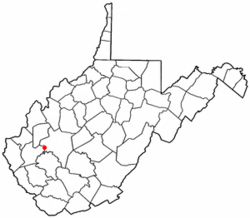Alum Creek, West Virginia facts for kids
Quick facts for kids
Alum Creek, West Virginia
|
|
|---|---|

Location of Alum Creek, West Virginia
|
|
| Country | United States |
| State | West Virginia |
| Counties | Kanawha, Lincoln |
| Area | |
| • Total | 10.28 sq mi (26.62 km2) |
| • Land | 10.21 sq mi (26.44 km2) |
| • Water | 0.07 sq mi (0.18 km2) |
| Elevation | 620 ft (189 m) |
| Population
(2010)
|
|
| • Total | 1,749 |
| • Density | 171/sq mi (66.2/km2) |
| Time zone | UTC-5 (Eastern (EST)) |
| • Summer (DST) | UTC-4 (EDT) |
| ZIP code |
25003
|
| Area code(s) | 304 |
| FIPS code | 54-01396 |
| GNIS feature ID | 1549563 |
Alum Creek is a small community in West Virginia, USA. It is known as a census-designated place (CDP). This means it's an area identified by the government for statistics, but it's not an officially incorporated town.
Alum Creek is located along the Coal River. It stretches across parts of two counties: Kanawha and Lincoln. In 2010, about 1,749 people lived there. The community gets its name from a nearby stream, also called Alum Creek, which flows into the Coal River.
Contents
Where is Alum Creek?
Alum Creek is mostly in the northeastern part of Lincoln County. A small part of it also crosses the Coal River into Kanawha County. The center of the community is located at 38°16′45″N 81°49′32″W / 38.27917°N 81.82556°W.
The total area of Alum Creek is about 26.6 square kilometers (10.3 square miles). Most of this area is land, with a small amount of water. The Coal River flows through Alum Creek. This river is part of the larger Kanawha River system.
People of Alum Creek
In 2000, there were 1,839 people living in Alum Creek. This number went down slightly to 1,749 by 2010. The community has a mix of families and individuals. The average age of people living in Alum Creek in 2000 was 40 years old.
History of Alum Creek
The area that is now Alum Creek started as a town called Rome in the 1890s. It was founded by the Childress family. Rome was located where the Little and Big Coal rivers meet.
Coal and Railways
Soon, the Chesapeake and Ohio Railway built a train line along the Coal River. This railway was important for moving coal from mines in Boone and Logan counties. The coal was taken to a main hub in the nearby town of St. Albans.
As the town grew, a local council was formed. In 1910, the town officially changed its name from Rome to "Alum Creek."
Bridges and Growth
In 1922, important bridges were built across the Big and Little Coal rivers. These bridges helped connect different parts of the community. Around this time, a company called Union Carbide built a summer camp called Cliffside along the Coal River.
For about 50 years, Alum Creek thrived. Many people worked in the coal mining or chemical industries. Two elementary schools were built: Alum Creek Elementary in Kanawha County and Midway Elementary in Lincoln County. A high school, Washington District High School, was also built in the 1930s. However, this high school closed in 1980 due to schools combining.
Modern Changes
In the mid-1980s, a major road, U.S. Route 119, was built through Alum Creek. This brought new businesses to the area. Even with new businesses, the community faced challenges because the coal mining and chemical industries declined. However, Alum Creek is now seeing a comeback as more businesses open along Route 119.
A historic house called Holley Hills Estate is located near Alum Creek. It was added to the National Register of Historic Places in 1980.
Important Places
Here are some notable places in Alum Creek:
- Swinging Bridges - These were the first bridges built in 1922 to cross the Coal River. They are located at the Forks of Coal, where the Big and Little Coal Rivers meet.
- Midway Elementary - An elementary school located on the Lincoln County side.
- Alum Creek Elementary - An elementary school located on the Kanawha County side.
- Washington District High School - This is a closed school building. It stands across the street from Alum Creek Elementary.
- Lions Club Park - A community park located on Coal River Road.
- Forks of Coal Missionary Baptist Church - This church was founded in 1832 and has a historic cemetery around it.
See also
 In Spanish: Alum Creek (Virginia Occidental) para niños
In Spanish: Alum Creek (Virginia Occidental) para niños

